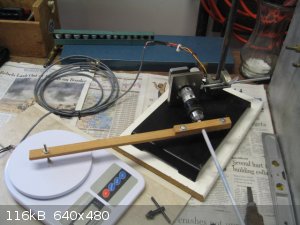
Magpie - 22-5-2015 at 16:17
I plan to upgrade my stepper motor mixer with a faster motor to allow a speed increase from the present 221 rpm to at least 600 rpm and more likely
higher.
In selecting a new motor I needed to know something about the torque requirement. As this is difficult to calculate I instead felt I should find out
what torque I presently have as I do have mixing experience with it. Its torque has so far been more than adequate.
To measure the torque I constructed a simple de Prony brake. Using this and my scale I could measure the torque. The maximum torque measured at 191
rpm was 20.9 in-oz (14.8 N-cm).
A YouTube video of the dynamometer in use can be viewed here:
https://youtu.be/a9mbiZ74dhY

[Edited on 23-5-2015 by Magpie]
[Edited on 23-5-2015 by Magpie]
[Edited on 23-5-2015 by Magpie]
smaerd - 22-5-2015 at 16:26
That's a really clever way to approach measuring torque. I was concerned about torque for my rotovap project but winged it and got pretty lucky. Now
that I know I can do this, I'll be sure to employ it from now on!
Magpie - 22-5-2015 at 17:54
Thanks, smaerd. I didn't do much research to learn how to build this de Prony brake. I just saw a sketch of one for an electric motor in my college
dynamics book.
I bolted two pieces of wood together then drilled a hole at their interface just a little smaller than the shaft of my mixer. Then I separated the
two wood pieces about 1/8" with two pieces of cardboard and tightened the bolts. Then I drilled the slightly separated halves of the hole larger with
a bit one size bigger than the mixer shaft.
To increase the torque incrementally I successively tightened the bolts measuring the torque after each tightening. This was done until the mixer
shaft would not turn due to excessive torque.
Zombie - 23-5-2015 at 00:17
Very clever. I admire the effort. Your stirrer was one of the very first threads I posted on here, and I'm glad to see it is still serving you well.
Albeit upgrading... It's still nice to see.
jock88 - 23-5-2015 at 15:15
Am I right in saying that that only measures static torque so it may not represent torque at (say) 400 revs?
Magpie - 23-5-2015 at 18:55
I think you are right as even though the shaft is rotating there is no acceleration. So I erred in my YouTube video in calling it a dynamic torque.
j_sum1 - 23-5-2015 at 19:09
I think if you have a way of measuring the rotation speed you can construct a graph of torque vs angular velocity. Then you have all the information
you could possibly want.
Measuring rotation could be as simple as adding a bicolour disc to the shaft and recording some video.
jock88 - 24-5-2015 at 04:59
Measuring the torque at different speeds would be the hard bit. You would need a transducer on the shaft (or something like that)
An ordinary squirrel cage motor (not what we have here of course) produces zero torque when allowed to run up to its full unloaded speed. You have to
put a load on it, them some slip occurs and you are now getting torque
Magpie - 24-5-2015 at 06:55
My tachometer is electronic, taking pulses from my motor driver module. I'm presuming that this is an accurate speed even when under high torque
load.
My method for measuring the torque at this set speed, 191 rpm in the case shown, was to tighten down the clamp bolts until the motor was on the verge
of a stall. Using the de Prony brake force indication I then calculated a torque of 20.9 in-oz. For my purposes this is all I needed. This value is
in the ballpark with published data for NEMA 17 stepper motors operated within my limitations (12 vdc, 2a).
Being that I salvaged my Mineba stepper motor from a junked Savin copier I had no torque data for the motor nor could I get any from Mineba. It is
likely proprietary to Savin.
jock88 - 24-5-2015 at 10:01
I did not realize that the motor was spinning when pressing down on the scales. Sorry aboout that. Did not watch utube video. Bandwith restrictions.
